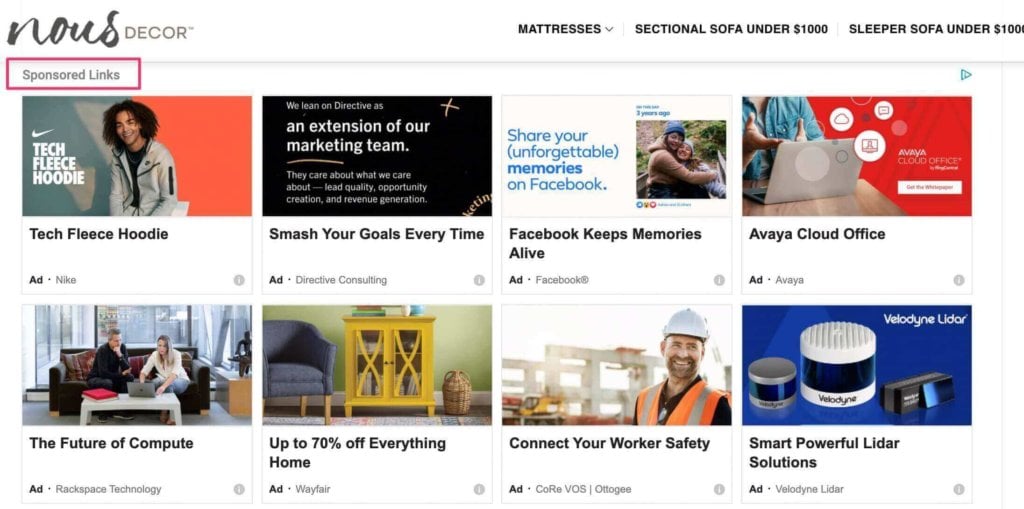Native Ads vs Display Ads | Main Differences Explained
The first display ad was served on HotWired.com in 1994. Native advertising as well as display advertising have been around for a long time, but with the rise of Artificial Intelligence and its powerful targeting opportunities, it has become more popular than ever.
Both display and native ads have a huge advertising demand because they’re great way to promote products and increase brand awareness. But which one is better for your website?
In this article, you’ll learn the main differences between display and native ads, and which of them you should use.
What are Display Ads?
Display ads also known as banner ads. They’re the most popular type of display advertising. This type of ads appeal to the audience through visual content.
Display ads vary in shapes and sizes. They can be displayed at the top of the page (billboard banner), on the side (sidebar banner), between paragraphs of text, and more.
Due to the evolution of advertising technology, today you can find display ads with interactive elements, like video, audio, and clickable elements, known as rich media ads.
Example of Display Ads
- Display ad is fully clickable

Source: Ad Tech Daily
- Banner ad with clickable element

Source: Entrepreneur
What are Native Ads?
Native ads ‘blend’ into the publisher’s content. Native ads work by matching the website’s design, look and feel. Therefore, they provide a better user experience compared to other ad formats because users don’t get interrupted by flashy ads while consuming the content.
Setupad provides publishers with native ads alongside other advanced ad formats.
IAB currently divides native ads into 3 formats:
- In-Feed/ In-Content Units
- Content Recommendation Ads
- Branded/ Native Content
Usually, you can identify native ads on the website as those with a “promoted” or “sponsored” message next to them.

Moreover, native ads don’t just come in different sizes but also formats, such as video ads and recommendation blocks.
Native Ad Examples
Native ad examples are most common across in-feed units, recommendation widgets, and promoted listings.
- In-feed units appear directly in the article, blog post, or the social network newsfeed.

Source: Entrepreneur
- Content recommendation ads appear as a recommended content on the publisher’s website (supplied by content discovery platforms like Outbrain and Taboola).

Source: Business Insider
- Branded/ native content appears as a paid editorial content from a brand and is usually created in collaboration with the publisher’s content teams.

Source: Macworld
- Promoted listings usually appear on e-commerce websites as products or services offered by a given website and labeled as “sponsored” or similar. (Note, this format is now a part of the In-Feed native)

Source: Gumtree
Related Article: The Step-By-Step Guide to Native Advertising
Main Difference Between Native Ads and Display Ads
Unlike display ads, native ads intentionally don’t look like ads; instead, they look like part of the editorial flow of the webpage.
| Native Ads | Display Ads |
| Blend in with the surrounding content | Stand out from the rest of the content |
| Ads are consumed as content | Can be overlooked because of ad blindness |
| Best for driving traffic to the advertiser’s website | Best for remarketing campaigns |
| CTR 0.8% (8.8x higher than display ads) | CTR 0.09% |
| Higher viewability (about 53% than standard display ads) | Lower ad viewability |
Source: Kiplinger
Setupad Expert Opinion
Povilas Goberis, COO at Setupad: “Regarding the comparison of average CTR, it very much depends on the situation. Generally speaking, CTR is supposed to be higher for native ads, but in some cases, this is not necessarily the case.”
P. Goberis says: “For example, with a regular display ad without special clickable elements, the user can click on the whole ad, while a native ad may have specific clickable elements: image, title, or advertiser’s logo.”
P. Goberis continues: “So, in this case, CTR might be lower for the native ad than for a regular display ad, but on the other hand, the click itself might be more organic and meaningful. Additionally, the content around the native ad would also influence the probability of the ad being clicked on.”
What are Setupad Native Ads?
Setupad offers two types of native ads–single native and multiplex ads. Multiplex ad format serves many native ads within an ad slot. Setupad adjusts native ads’ style to match the website’s design as closely as possible.
Setupad Native Multiplex Ad

Source: NousDecor
Our clients also benefit from an additional layer of demand not just from Google, but also 28 demand partners (SSPs) like Xandr, Pubmatic, OpenX, and others.
In addition, we run both native and display ads in the same ad placement to increase the overall ad revenue for particular ad placement.

Source: Creatufrase
Native Ads or Display Ads, or Both?
According to Statista, US native ad spend has reached $52.75 bln in 2020. Native advertising segment has been showing progressive growth in the past years and the trend is here to stay.

Source: Statista
Native ads are designed to be non-disruptive, and thanks to their native feel, they provide a better user experience, ad engagement, CTR, and ad viewability.
However, native ads don’t always generate higher CPMs for publishers than standard banner ads.
Therefore, Setupad encourages publishers to use all available opportunities to maximize their yield. From our experience, a combination of both– display and native ads– is the right solution. Try Setupad ad formats for your site by signing up!


